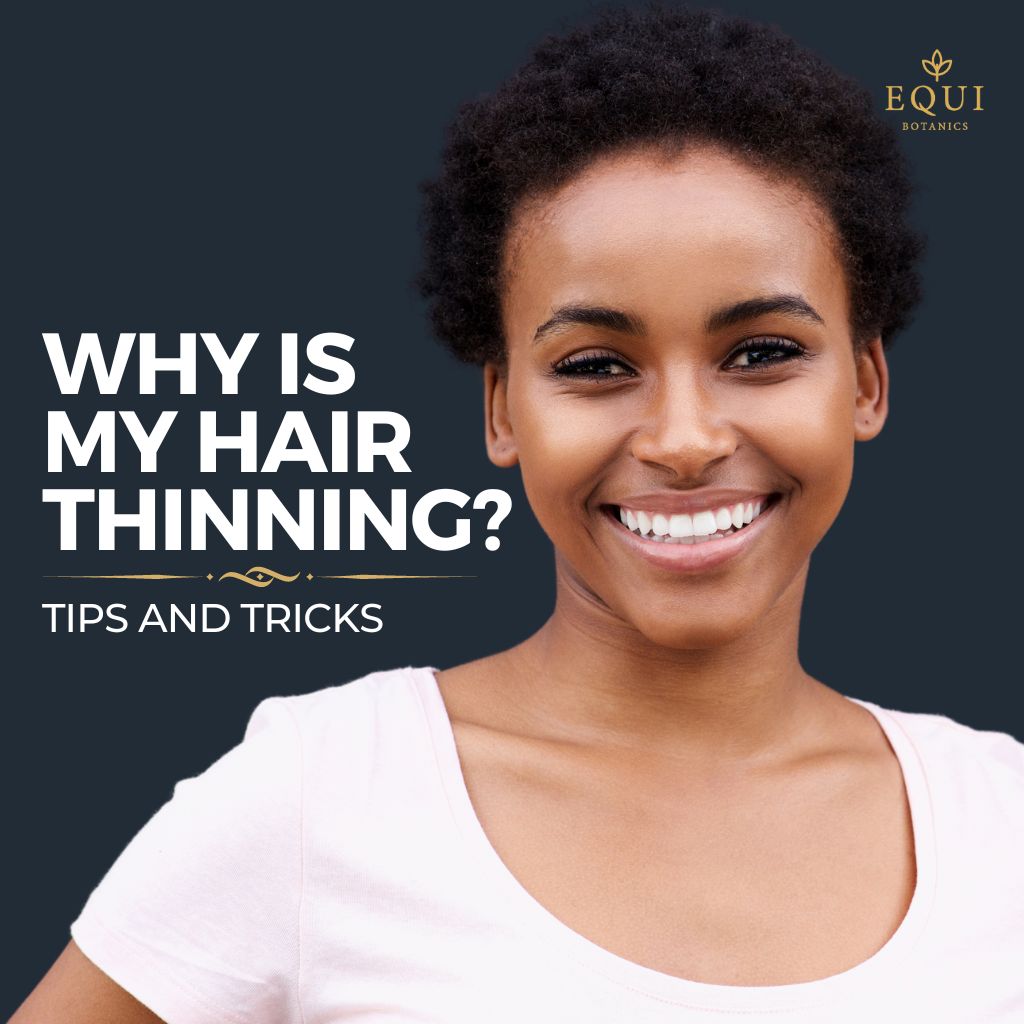
Key Summary
Causes of hair thinning include androgenetic alopecia, stress, certain medications, stress and hormonal imbalances.
To fix thinning hair you could consider methods such as increasing your protein intake, switching to natural hair care, using laser light therapy, and following a mediterranean diet.
In many cases, thinning hair can grow back but if it is a genetic factor causing the hair loss, it may be more difficult to fix.
What Causes Thinning Hair?
Suffering from hair loss can be distressing and you’ll understandably want a fix to the issue, quickly. There are various types of hair loss, and before you treat your thinning locks, you’ll need to understand both the type of hair loss you are suffering with and the possible causes.

There are myriad reasons for thinning hair. Here are some of the key culprits:
1. Hereditary Hair Loss
The most common cause of hair thinning is androgenic alopecia, which is often known as male or female pattern balding. This condition causes hair follicles to shrink and eventually stop growing hair.
In women, the first signs of hair thinning usually include overall thinning or a widening parting. For men, it often starts with a receding hairline or a bald spot at the top of the head.
2. Ageing
As we age, hair growth slows and hair follicles may eventually stop producing hair. This process results in hair thinning and greying. It's a natural part of ageing and affects most people to varying degrees.
3. Alopecia Areata
Alopecia areata is an autoimmune condition that causes hair loss. This chronic illness causes the body’s immune system to attack hair follicles. Typically, alopecia areata is identifiable as the hair loss is patchy rather than an all over thinning.
4. Stress and Illness
Significant life events like childbirth, an illness or surgery can trigger hair thinning. Traumatic or stressful occurrences and certain medications can also lead to hair thinning and loss. You might notice more hair on your brush or pillow a few months after these events.
5. Hair Care Practices
Certain hair care practices can contribute to hair thinning. Colouring, perming, relaxing or using heating tools can damage your hair over time, leading to hair loss, thinning and breakage.
6. Traction Alopecia
Traction alopecia is as a result of a repeated pulling to the hair as a result of tight hairstyles, such as ponytails and braids, hair extensions, or weaves. The stress from this repetitive tension as a result of these hairstyles causes damage to the hair root and follicle which leads to hair loss and thinning. If left untreated, the damage can be permanent.
7. Hormonal Imbalance
A common cause of hair thinning in women is as a result of conditions like polycystic ovary syndrome (PCOS), thyroid issues, or menopause which can disrupt hormones and lead to hair thinning.
It's not uncommon for women to experience hair thinning during menopause, for example, because these conditions can create an imbalance between oestrogen and androgen hormones.
Oestrogen helps to keep hair in its longer growth phase, while androgens can shorten this phase and increase hair loss. When this balance is disrupted, the rate of hair growth can be affected, leading to thinning hair in women.
8. Scalp Infections
Certain scalp infections can lead to hair thinning as they damage the hair follicle, affecting the growth cycle of your hair and causing hair to fall out more easily. Additionally, the inflammation caused by these infections can weaken the hair shaft, leading to hair thinning and breakage. Early diagnosis and treatment of these infections are crucial to preventing permanent hair loss.
9. One-Sided Hair Thinning
Hair thinning on one side is often indicative of lifestyle factors, for example, consistently sleeping on one side, which might lead to friction and subsequent hair loss.
Similarly, if you often style your hair in a way that pulls or strains one side more than the other, it could lead to noticeable hair thinning on that side.
Over time, this strain can damage the hair follicles, leading to reduced hair growth and thinner hair on one side of the scalp.
How to Stop Thinning Hair
Now we’ve explored some possible causes, let’s take a look at how to fix thinning hair:
Eat Extra Protein
Your hair is primarily made up of a protein called keratin and as a result, protein is an essential nutrient for hair growth. The recommended daily intake is around 40 to 60 grams, but requirements may vary depending on your body weight, age, and lifestyle.
Good sources of protein include beans, lentils, eggs, or yoghurt. If you're vegan or vegetarian, consider incorporating more plant-based protein sources like tofu, tempeh, or chickpeas into your diet.
Take Vitamins
Deficiencies in certain vitamins and minerals can lead to hair loss. Consider taking a supplement rich in vitamins A, B, C, D, E, iron and zinc, all of which are necessary for maintaining healthy hair.
ℹ️ Biotin, in particular, is renowned for its hair health benefits as it helps produce keratin and can improve your hair's thickness.
Switching to Natural Hair Care
Switching to natural hair care products can help you to avoid substances, such as sulphates, which are highly damaging to your locks. Look for products that contain nourishing, restorative properties such as aloe vera, jojoba, coconut oil, or marula.
Using naturally derived hair products, such as the Nourish and Revive Deluxe Set will promote a healthy scalp which is essential for hair growth and can help to strengthen the hair shaft.
Nourish and Revive Deluxe Set
We've jam-packed this Nourish and Revive Deluxe Set with luxurious ingredients to give you a kickstart on your hair growth journey. We've selected our best-selling and hair replenishing treatments as part of the set. And because we really want you to have a great time, we're giving this set away for less than getting each product individually.
Furthermore, many natural ingredients, such as black seed oil, also have anti-inflammatory properties, which can help reduce any scalp inflammation that might be contributing to hair thinning.
Follow the Mediterranean Diet
The Mediterranean diet, praised for its heart health benefits, can also be beneficial for your hair. It's rich in fruits, vegetables, whole grains, and lean proteins—all nutrients that nourish your hair follicles and foster hair growth.
One particular study showed that consuming raw vegetables and fresh herbs, like parsley and basil – key elements of the Mediterranean diet – reduced the risk of androgenic alopecia or pattern baldness.
Use Hair Loss Medication
Hair loss medications (like minoxidil) can be an effective way to prevent further thinning and stimulate new growth. Minoxidil works by prolonging the growth phase of hair, resulting in thicker and longer hair strands.
Though it's available over the counter, it's best to consult with a healthcare professional before starting its usage, as it may not be suitable for everyone and does come with potential side effects.
Try Low-Level Laser Light Therapy
Low-level laser light therapy uses light to stimulate hair growth. This therapy works by using light to boost cell metabolism and reduce inflammation, encouraging hair follicles to grow.
Despite its promising results, it's worth noting that this method can be time-consuming and expensive.
Options range from home-use devices like combs and headbands to professional treatments at clinics. If you're considering this therapy, it's a good idea to consult with a hair loss professional to discuss its feasibility and potential effectiveness for your specific case.
Maintain Good Hair and Scalp Care
The way you treat your hair can significantly influence its health. Here are some tips:
Avoid Harsh Hair Treatments
Regular use of heat styling tools, hair dyes and bleach can weaken your hair and lead to breakage and thinning. Try to limit their use and always use a heat protection spray when styling.
Mind Your Hairstyles
Lose the risk of traction alopecia by avoiding tight hairstyles like ponytails, buns, or braids that can cause tension on the hair shaft. Opt for loose styles that don't pull on your hair and scalp. To learn more about hairstyles that can cause traction alopecia, watch this video:
Keep Your Scalp Clean and Healthy
Use a gentle, natural shampoo and conditioner that doesn't contain harsh chemicals. We love the Baobab Detangler & Cleanser. Whilst applying your chosen shampoo, perform a stimulating scalp massage to stimulate blood flow and promote healthy hair growth.
Baobab Hair Detangler & Cleanser
We prefer to avoid calling this a detangling shampoo. Instead, we call ours a detangling cleanser because it’s softening and moisturising while cleansing thoroughly. It also acts as your pre-poo detangler before you wash. Are you tired of that stripped feeling after you’ve just washed your hair? Wash your hair not strip it of its natural oils.
Can Hair Grow Back from Thinning?
One of the most common questions that people ask when it comes to hair loss and thinning is, can it grow back? Ultimately, reversing thinning hair will depend on the cause however, if your hair thinning is as a result of damaging hair practices or stress, there is a good chance that it will recover once the issues are addressed.
If the hair loss and thinning is a genetic factor, the process can be more challenging. When dealing with sudden hair thinning, it is important not to panic. Seek advice from your doctor or a trichologist to get to the root cause as with the right diagnosis and treatment, you can start to regain your hair's thickness and vitality. Remember, hair growth is a slow process, so patience is key.
Frequently Asked Questions (FAQs)
Q: Does the Type of Brush I Use Affect Hair Thinning?
A: The type of brush you use can certainly impact your hair health. Brushes with harsh bristles can cause damage to your hair, leading to breakage and thinning. It's generally recommended to use a brush with soft, natural bristles and to avoid tugging or pulling at your hair.
Q: Does Wearing a Hat Cause Hair to Thin?
A: Contrary to popular belief, wearing a hat doesn't cause hair loss or thinning. However, if the hat is tight enough to pull on the hair, it could potentially lead to traction alopecia, a form of hair loss caused by tension on the hair follicles.
Q: How Can I Tell if My Hair is Thinning Due to Breakage or Hair Loss?
A: Thinning due to breakage often results in uneven hair length and split ends. On the other hand, thinning due to hair loss typically involves shedding more hairs than usual. A healthcare professional or a trichologist can help you determine the cause of your hair thinning.
Q: How Long Does it Take to See Improvements After Starting Treatments for Hair Thinning?
A: This can vary greatly depending on the treatment method and the individual's specific situation. Some treatments may show results in a few weeks, while others may take months or even a year. Patience and consistency are key when it comes to treating hair thinning.
Conclusion
So, there you have it. Now you have some ideas as to why your hair is thinning and what you can do about it. Keep these tips in mind, stay consistent with your hair care regimen, and here's to thicker, healthier hair in the future!


